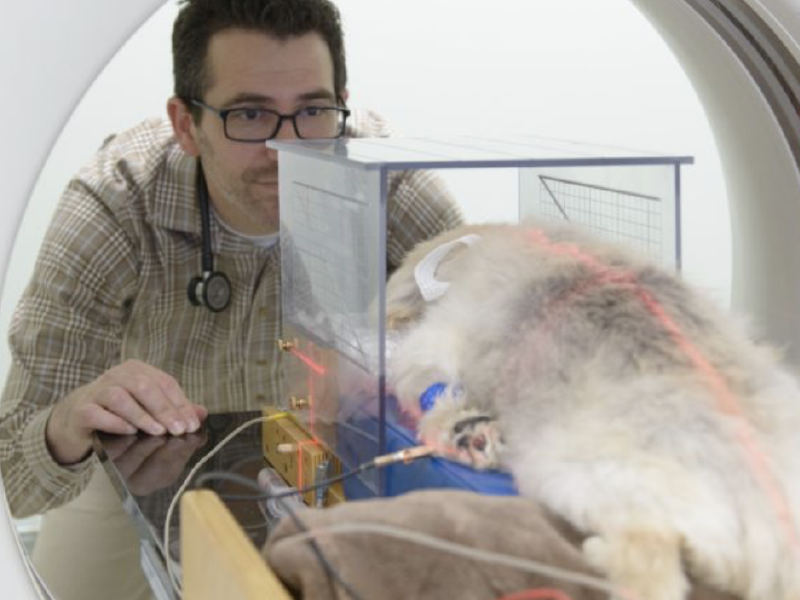Brain Cancer in Dogs: A Goldendoodle’s Battle with Cancer

I got the call on January 12, 2017 from my parents across the country in California that their (our) 10-year old Goldendoodle, Yankee, had just experienced a generalized seizure, the first of his life. It lasted for what seemed like an eternity but was probably just a few minutes and my parents were extremely worried. Fortunately, the episode subsided and no additional seizures occurred immediately.
A Visit to the Neurologist
I knew all too well that new-onset seizures in an otherwise healthy senior dog was most likely an indicator of a brain tumor. I had my parents take Yankee to see a Veterinary Neurologist a few days later. An MRI confirmed that he in fact, had a sizable brain tumor, likely a meningioma in the left frontal and temporal lobe of his brain. He was started on steroids and an anti-seizure medication.
Dealing with the Diagnosis
Brain cancer! My parents were devastated. They have loved and cared deeply for all of our pets, but Yankee has been that truly special dog that they take everywhere and do everything with. They asked how could they not have known that anything was wrong? In retrospect, maybe there had been some changes that they assumed were just from getting older. I’ve probably spoken with a few hundred families about their pets’ brain tumors. I try to treat every pet as though it were my own, but this certainly felt different.
Radiation Therapy
We discussed the fact that brain tumors can be unpredictable and things can change suddenly. I felt that Yankee was a good candidate for radiation therapy. The odds suggest that with medications alone, Yankee might have 2-4 months before his symptoms returned, progressed, and became life-threatening.
My parents were initially quite reluctant to want to treat him. They were worried about the challenges and side effects of therapy and the fact that we could do everything, and it might not work. After difficult consideration, we all agreed that fighting with Yankee and for Yankee was what we wanted to do.
After considering the radiation treatment options, including a conventional full-course treatment, we elected to go with a 3-treatment stereotactic radiation course. I told them he should have a better than 50% chance of being alive and well in one year. Some dogs can do well for many years after treatment!
From California to Virginia: Yankee Comes to TOS
The next tough decision was where to treat him. I have several close and outstanding radiation oncology colleagues that live in Southern California, but we decided to have my parents fly Yankee out to Virginia for treatment with The Oncology Service.
This was finally an opportunity for me to utilize the countless years of training and clinical experience I have to provide them with the best treatment for their dog. I’m sure it sounded arrogant, but I told them that I am literally one of the most skilled and qualified veterinarians in the world for what Yankee needs.
So Yankee flew to Virginia with my parents, and we treated him in our Leesburg office. I worked with Dr. Pamela White and the amazing technical staff in Leesburg to construct and deliver an optimal radiation plan.
One week later…
The whole course was complete in one week. Yankee did amazing during therapy; he was spoiled with affection in the evenings and treated in the mornings (where he was also spoiled with affection by medical team). Despite me being nervous about it, he flew back home a few days after finishing treatment.
Post-Treatment Side Effects
It wasn’t entirely smooth sailing. About 1-2 weeks after getting home, the daily updates I was receiving from my parents went from pure joy to progressive concerns that Yankee “didn’t seem like himself”. He wasn’t sick, but he seemed tired and out of it. He wasn’t responding to his commands and cues like normal. He seemed confused at times and would go to his doggie door and seem like he’d forgotten how to use it.
I told them that it was most likely that Yankee was suffering from what we refer to as acute-delayed radiation side effects on the brain or transient demyelination. While the signs are potentially identical to more serious tumor or radiation complications, we can see about 30% of dogs develop these signs and they should resolve within a few weeks.
Sure enough and thankfully, this is exactly what happened with Yankee.
Happy Days for Yankee
After a few more weeks, he was back to his old self, maybe better! He tapered down and came completely off of prednisone over a couple of months. He continued on his seizure medications but had been seizure-free.
Soon enough, we reached the 1-year anniversary of Yankee’s diagnosis and treatment. My father missed Thanksgiving at my house because he didn’t want to leave Yankee at home alone! Overall, it had been a wonderful year for Yankee and my family, filled with time together and cherished memories. He lived 14-15 months after his initial diagnosis before passing away.
I had a few other canine brain tumor patients that I was treating around the same time as Yankee. Every time they came back in for rechecks, their owners asked about the others, and we collectively celebrated the successes and worries for each other.
My Work as a Veterinary Oncologist
I am so thankful to have the opportunity to work with families like my own that are willing to allow me to fight with them and their pets against challenging diseases. Having personal experiences like this one with Yankee is a reminder of how difficult the choices and process is for each family as well as how meaningful it can be to be able to have a little bit more time with a special animal family member.
Written by Ira Gordon, DVM, DACVR (Radiation Oncology)
